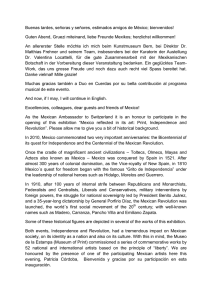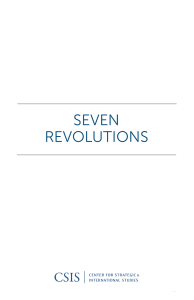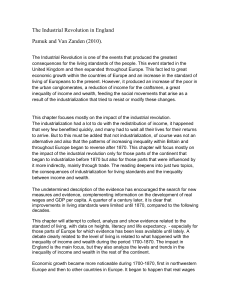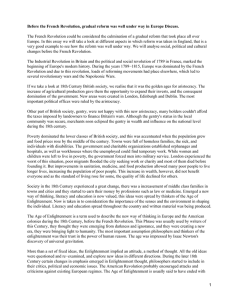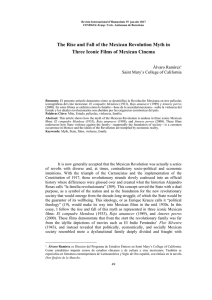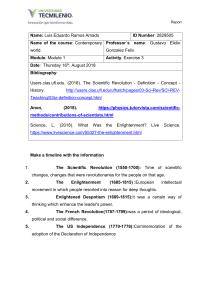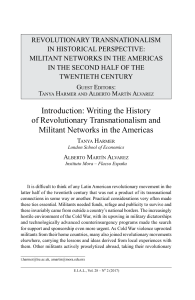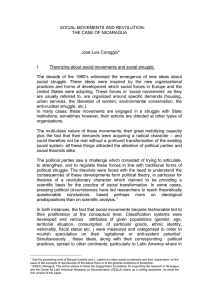Review/Reseña Building the Monster: Writing an Architectural
Anuncio
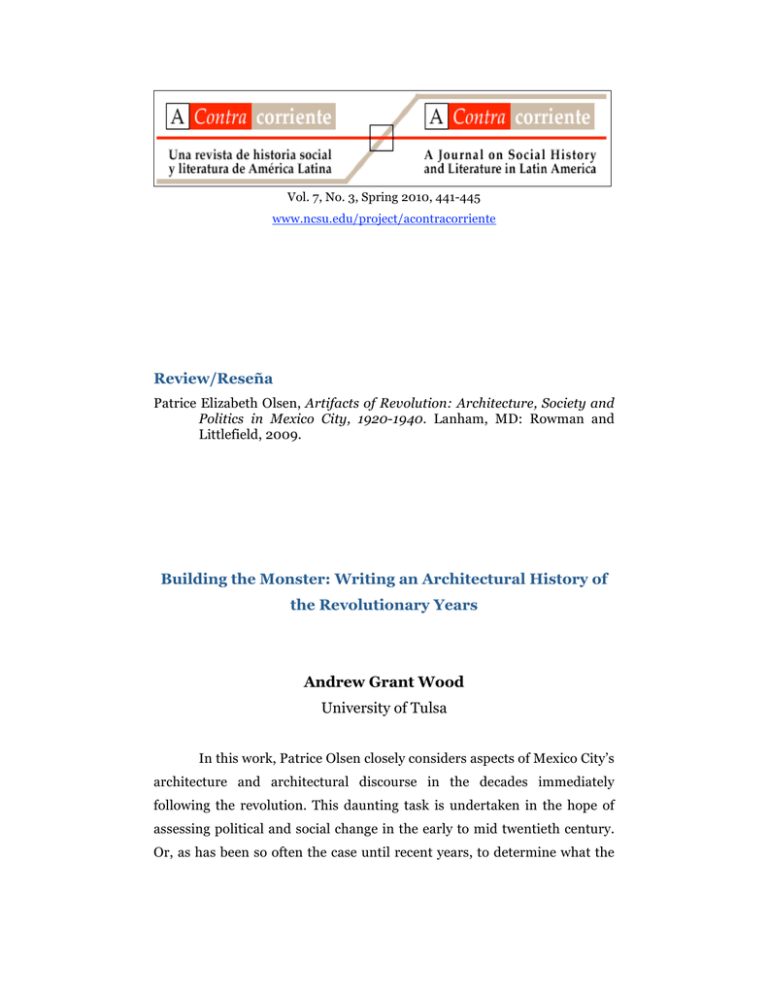
Vol. 7, No. 3, Spring 2010, 441-445 www.ncsu.edu/project/acontracorriente Review/Reseña Patrice Elizabeth Olsen, Artifacts of Revolution: Architecture, Society and Politics in Mexico City, 1920-1940. Lanham, MD: Rowman and Littlefield, 2009. Building the Monster: Writing an Architectural History of the Revolutionary Years Andrew Grant Wood University of Tulsa In this work, Patrice Olsen closely considers aspects of Mexico City’s architecture and architectural discourse in the decades immediately following the revolution. This daunting task is undertaken in the hope of assessing political and social change in the early to mid twentieth century. Or, as has been so often the case until recent years, to determine what the Wood 442 decades of revolution (or to reify: “the revolution”) may have actually meant. Like others before her, the author uses the Mexican capital as a metonym for the nation. She writes, “the city invites analysis beyond a cataloging of notable buildings—as the nation’s capital is a composite of the national experience in both practical terms, in the administration of a new, at times tentative revolutionary government and in ceremonial/symbolic terms” (xiii). From this premise, Olsen asserts that “the built environment reveals asymmetries in power and the distribution of resources” and that “[i]t is this aspect of Mexico City architecture that tells the observer what happened to the revolution” (xiv). Revolutionary conflict had destroyed much and significantly drained the nation financially. Thousands displaced by the violence in rural areas had fled the countryside and settled, however dubiously, into crowded urban tenements and makeshift shantytowns. Increasing demand for decent housing and access to basic services in downtrodden pockets of the city center as well as in rapidly expanding peripheral areas pressured successive government administrations. If the Great Men of the revolution were to carry any political weight, something, however superficial, presumably needed to be done about the hideous condition of ordinary people living in Mexico’s capital city. Rising population, coupled with improvements in medical technology and a creeping, yet persistent modernity from abroad also demanded that the nation provide not only for potable water, paved streets and roads, electricity and a modicum of enforceable building code regulations, but also the construction of schools, libraries, hospitals, clinics, and related research facilities, not to mention many other cultural and technological initiatives. The nation needed to be rebuilt and redirected in any number of ways. Yet while some of the directives may have appeared clear as day, other investment strategies during the 1920s and 1930s remained highly contested. A significant social divide existed over the extent to which resources should be dedicated for public projects and the degree to which control over private enterprise could legitimately be exercised by the state. Building the Monster 443 Further, many elites took on the slippery task of identifying who and what the nation had become in the wake of the revolution. What, in other words, did it mean to be Mexican and how should that identity be reflected in social and cultural terms? Olsen relates how in the 1920s, a new generation of architects seriously asked themselves this question. Several began taking part in discussions at conferences and subsequently had the occasion to discuss how they might render an architecture that articulated the nation’s “fundamental, ethical and aesthetic values” (3). Of course, assumed recent graduates of the Academy of San Carlos Jesús T. Acevedo and Carlos Obregón Santacilia among others, the still recent Porfirian importations and eclecticisms had to go. In place of this, they suggested that a neoColonial style mixed with a certain revolutionary panache might unify a new Mexican architecture. Never mind that the neo-Colonial would inevitably borrow from past European styles such as the Churrigueresque, Renaissance and Baroque, for example, or, however ironically, that preColumbian symbols and design would at times be integrated into this neoColonial preference. What mattered was the Mexican ability to “interpret imported styles in their own manner” (7). Moreover, deployment of a neo-Colonial style, as Olsen contends, would most likely prove non-threatening to conservative elements in a society still squeamish about the new revolutionary order. Ensuing projects conducted during the Obregón administration under the auspices of Secretary of Education José Vasconcelos, including the National Stadium designed by José Villagrán García (inaugurated in May 1924), largely proved out the neo-Colonial compromise. Tragically, however, many authentic structures—notably properties of the Catholic Church—fell victim to the wrecking ball or suffered in unconscionable alteration during this same time. Soon, other needs began to challenge the preferred neo-Colonial direction. Rising land and material costs and a desire for greater light and ventilation, among other concerns, all pressed architects to conceive more broadly. Others, including young architects Juan O’Gorman, Álvaro Aburto, and Jean Legarreta felt that the neo-Colonial style could not keep pace with Wood 444 the extraordinary demands of Mexican society, not to mention the fact that designers might simply be “replac[ing] one set of symbols embedded in the exotic eclecticism of the Díaz era for another, equally irrelevant to current conditions” (21). Most significantly, Obregón Santacilia’s design for the building of the Secretariat of Health and Welfare at the corner of Reforma and Leija offered neither a neo-Colonial- nor pre-Columbian-inspired creation but, rather, a promising structure that engendered an innovative and often simple use of traditional materials. For many, the result represented an important “move away from foreign influences [in order to] depict the true national spirit” (17). But at the same time it seems that this work served as a portent for what soon followed, as Mexican architects moved increasingly away from revivalist styles (however rethought in the national context) and towards the functionality of what would later be generally termed the International Style. Olsen mentions that O’Gorman had read Le Corbusier’s Toward a New Architecture several times before he was twenty years old. He soon learned of other modernist transformations taking shape at the Bauhaus as well. As in Europe and the United States, innovations in the form of steel and concrete further encouraged such inquiry. Meantime, advertising, automobiles, tourism, industry, and accelerated colonization and subdivision of lands all contributed to the constant remaking and expansion of Mexico City. Keeping track of these and other related political developments, Olsen describes how administrations from Calles to Cárdenas expanded the power of the federal government while at the same time trying to legitimate their rule by mollifying “the masses” with the occasional new public housing tract, school, clinic, library or sports stadium spectacular. She often tells how architecture served elite political discourse at the time. For example, in describing Obregón Santacilla’s plans for the Monument to the Revolution, Olsen comments that “the center of the Monument was to be left empty: a contemplative space in which the permanence of the Revolution could be recalled in the opinion of the architect” (79). Acknowledging subsequent donations from across the country to help fund construction of the project, Building the Monster 445 the author interestingly provides some sense of not only the official, but also opposing views of the work. Having visited the monument myself in recent years and strolled around the area that rather unceremoniously plays host to the massive structure, I can relate to a certain feeling of hollowness embodied in structure rather than anything resembling revolutionary inspiration. Others at the time were obviously not being seduced by flowery revolutionary rhetoric as they simply referred to the Monument to the Revolution as an oversized gas station (82). Despite much construction, debate and revolutionary rhetoric, many of the old binaries persist: rich and poor, state and market, public construction in contrast to private residence and business preferences and so on. Still, by 1940, Olsen figures that “the city was less a product of a dominant upper class, as it had been under Díaz, and more a product of socio-economic forces introduced and nourished by the revolution…[I]n the end it remained…a negotiated space” (249). Olsen’s long awaited study does indeed present much in terms of architectural history and debate as related to the many commissions, political networks, exercises of power, and machinations of the market during the first half of the twentieth century. Yet, somehow, the city itself seems to have refused to cooperate in being reduced to a “text” or “cityscape” to be “read”—to use terms that Olsen so often relies on. Instead, it remains largely an indecipherable monster—perhaps even a myth—much like “the revolution”, in that “it” continually eludes us as we attempt to understand it as a whole. (Quite unhelpful here is the sad fact that the volume includes no photos or illustrations—a glaring omission on the part of the press). Still, in this otherwise impressive piece of work, Patrice Olsen has provided us a very useful study chronicling some of the key early twentieth century challenges and changes sustained by the Mexico City built environment.
